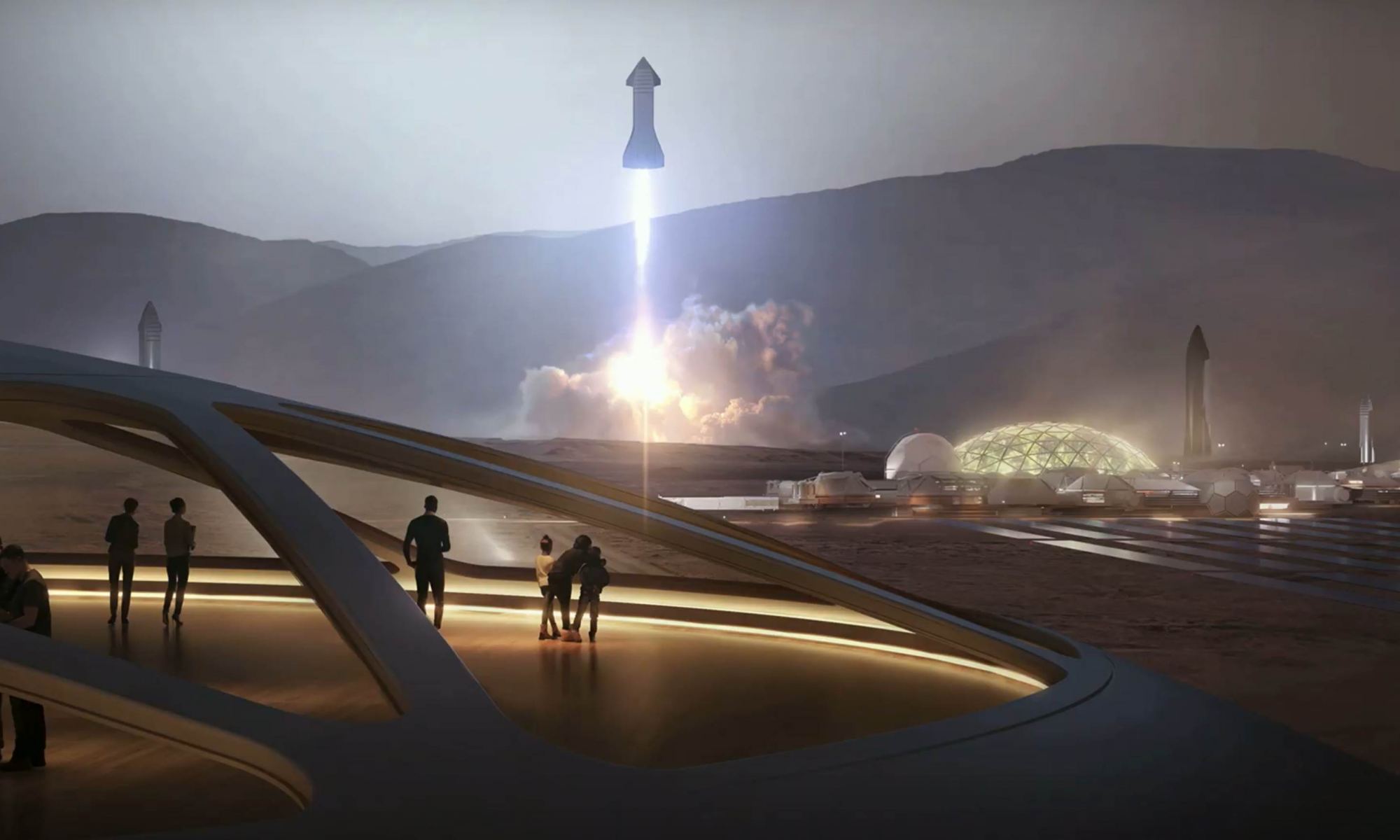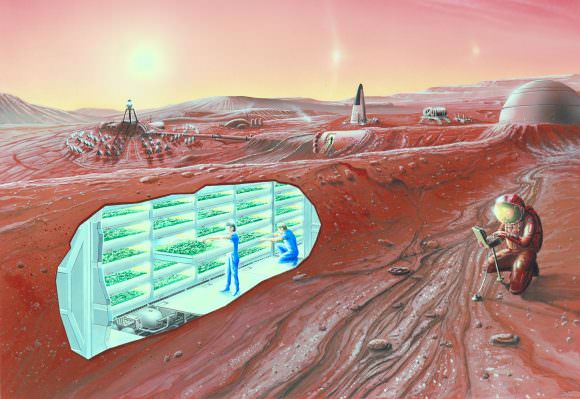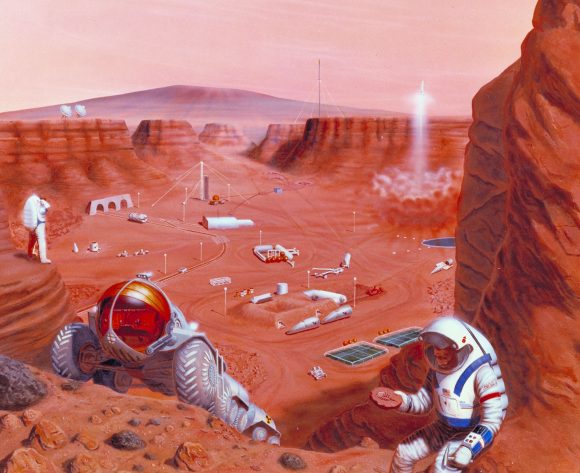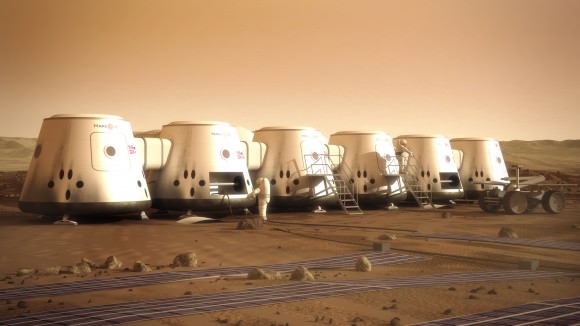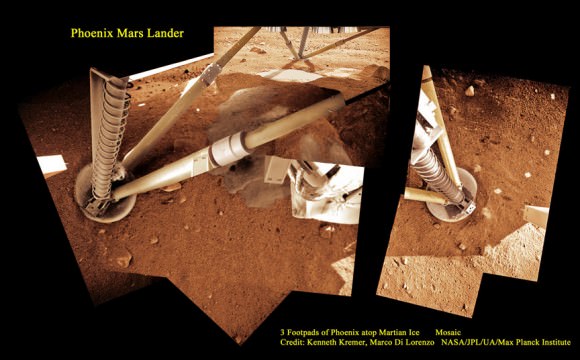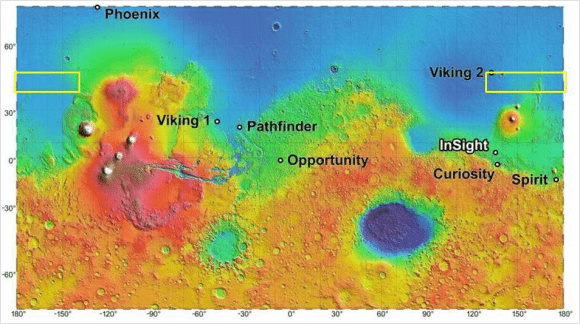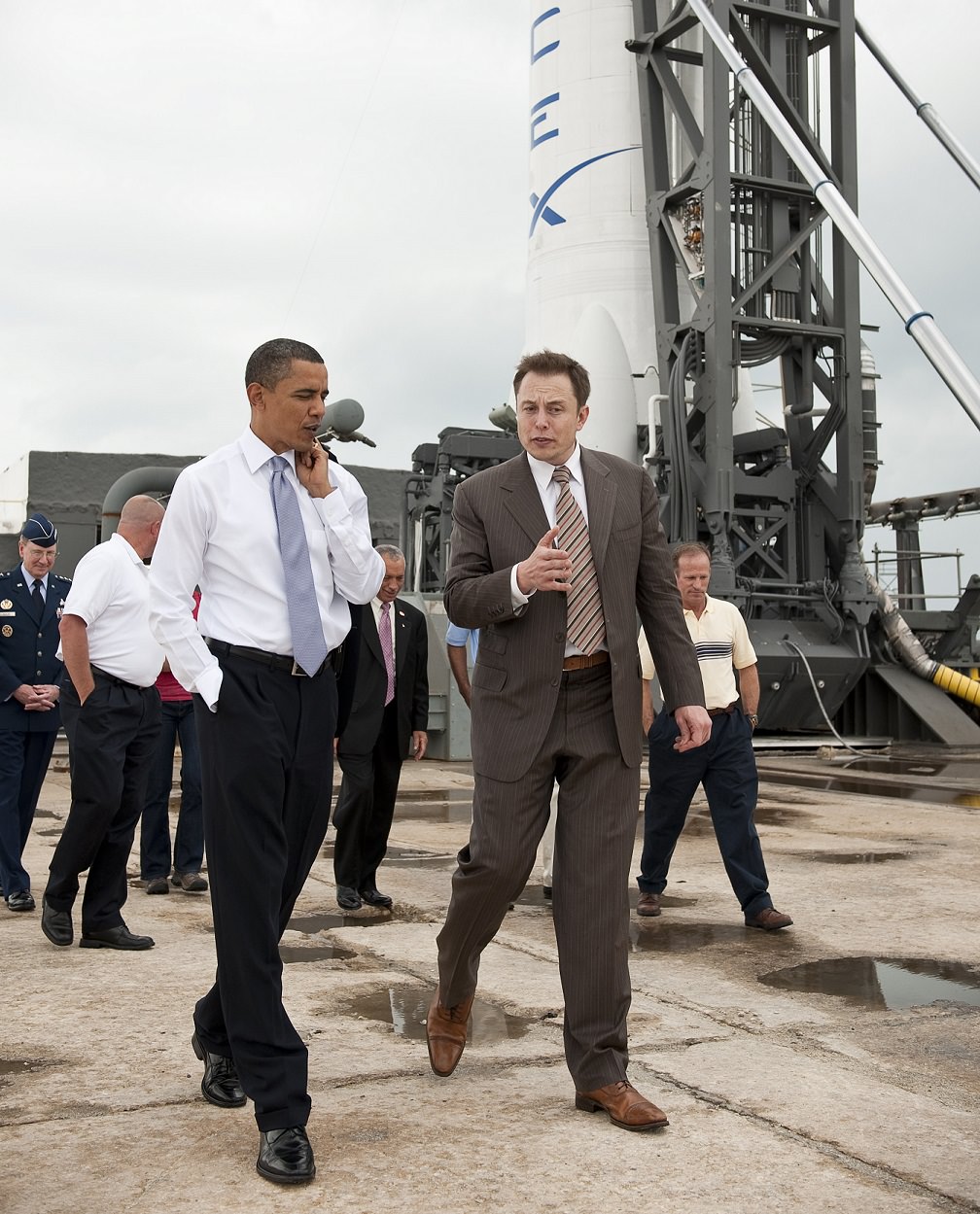Welcome back to our series on Settling the Solar System! Today, we take a look at that cold and dry world known as “Earth’s Twin”. I’m talking about Mars. Enjoy!
Mars. It’s a pretty unforgiving place. On this dry, desiccated world, the average surface temperature is -55 °C (-67 °F). And at the poles, temperatures can reach as low as -153 °C (243 °F). Much of that has to do with its thin atmosphere, which is too thin to retain heat (not to mention breathe). So why then is the idea of colonizing Mars so intriguing to us?
Well, there are a number of reasons, which include the similarities between our two planets, the availability of water, the prospects for generating food, oxygen, and building materials on-site. And there are even long-term benefits to using Mars as a source of raw materials and terraforming it into a liveable environment. Let’s go over them one by one…
Examples in Fiction:
The idea of exploring and settling Mars has been explored in fiction for over a century. Most of the earliest depiction of Mars in fiction involved a planet with canals, vegetation, and indigenous life – owing to the observations of the astronomers like Giovanni Schiaparelli and Percival Lowell.
However, by the latter half of the 20th century (thanks in large part to the Mariner 4 missions and scientists learning of the true conditions on Mars) fictional accounts moved away from the idea of a Martian civilization and began to deal with humans eventually colonizing and transforming the environment to suit their needs.
This shift is perhaps best illustrated by Ray Bradbury’s The Martian Chronicles (published in 1950). A series of short stories that take place predominantly on Mars, the collection begins with stories about a Martian civilization that begins to encounter human explorers. The stories then transition to ones that deal with human settlements on the planet, the genocide of the Martians, and Earth eventually experiencing nuclear war.
During the 1950s, many classic science fiction authors wrote about colonizing Mars. These included Arthur C. Clarke and his 1951 story The Sands of Mars, which is told from the point of view of a human reporter who travels to Mars to write about human colonists. While attempting to make a life for themselves on a desert planet, they discover that Mars has native life forms.
In 1952, Isaac Asimov released The Martian Way, a story that deals with the conflict between Earth and Mars colonists. The latter manage to survive by salvaging space junk and are forced to travel to Saturn to harvest ice when Earth enforces an embargo on their planet.
Robert A. Heinlein’s seminal novel Stranger in a Strange Land (1961) tells the story of a human who was raised on Mars by the native Martians and then travels to Earth as a young adult. His contact with humans proves to have a profound effect on Earth’s culture, and calls into questions many of the social mores and accepted norms of Heinlein’s time.
Philip K. Dick’s fiction also features Mars often, in every case being a dry, empty land with no native inhabitants. In his works Martian Time Slip (1964), and The Three Stigmata of Palmer Eldritch (1965), life on Mars is presented as difficult, consisting of isolated communities who do not want to live there.
In Do Androids Dream of Electric Sheep? (1968), most of humanity has left Earth after a nuclear war and now live in “the colonies” on Mars. Androids (Replicants) escaping illegally to come back to Earth claim that they have left because “nobody should have to live there. It wasn’t conceived for habitation, at least not within the last billion years. It’s so old. You feel it in the stones, the terrible old age”.
Kim Stanley Robinson’s Mars trilogy (published between 1992–1996), Mars is colonized and then terraformed over the course of many centuries. Ben Bova’s Grand Tour series – which deals with the colonization of the Solar System – also includes a novel titled Mars (1992). In this novel, explorers travel to Mars – locations including Mt. Olympus and Valles Marineris – to determine is Mars is worth colonizing.
Alastair Reynolds’ short story “The Great Wall of Mars” (2000) takes place in a future where the most technologically advanced humans are based on Mars and embroiled in an interplanetary war with a faction that takes issue with their experiments in human neurology.
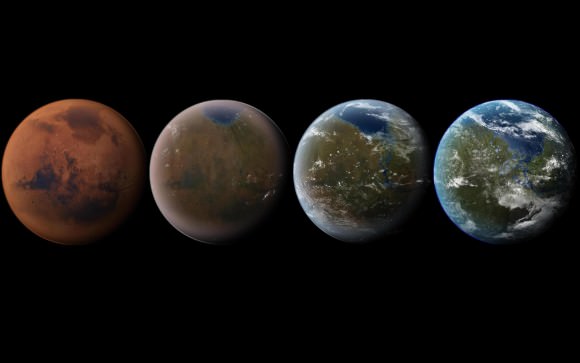
In Hannu Rajaniemi’s The Quantum Thief (2010), we get a glimpse of Mars in the far future. The story centers on the city of Oubliette, which moves across the face of the planet. Andry Weir’s The Martian (2011) takes place in the near future, where an astronaut is stranded on Mars and forced to survive until a rescue party arrives.
Kim Stanley Robinson’s 2312 (2012) takes place in a future where humanity has colonized much of the Solar System. Mars is mentioned in the course of the story as a world that has been settled and terraformed (which involved lasers cutting canals similar to what Schiaparelli described) and now has oceans covering much of its surface.
Proposed Methods:
NASA’s proposed manned mission to Mars – which is slated to take place during the 2030s using the Orion Multi-Purpose Crew Vehicle (MPCV) and the Space Launch System (SLS) – is not the only proposal to send humans to the Red Planet. In addition to other federal space agencies, there are also plans by private corporations and non-profits, some of which are far more ambitious than mere exploration.
The European Space Agency (ESA) has long-term plans to send humans, though they have yet to build a manned spacecraft. Roscosmos, the Russian Federal Space Agency, is also planning a manned Mars mission, with simulations (called Mars-500) having been completed in Russia back in 2011. The ESA is currently participating in these simulations as well.
In 2012, a group of Dutch entrepreneurs revealed plans for a crowdfunded campaign to establish a human Mars base, beginning in 2023. Known as Mars One, the plan calls for a series of one-way missions to establish a permanent and expanding colony on Mars, which would be financed with the help of media participation.
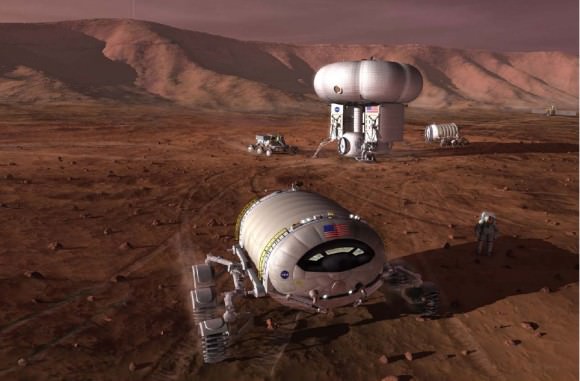
Other details of the MarsOne plan include sending a telecom orbiter by 2018, a rover in 2020, and the base components and its settlers by 2023. The base would be powered by 3,000 square meters of solar panels, and the SpaceX Falcon 9 Heavy rocket would be used to launch the hardware. The first crew of 4 astronauts would land on Mars in 2025; then, every two years, a new crew of 4 astronauts would arrive.
On December 2nd, 2014, NASA’s Advanced Human Exploration Systems and Operations Mission Director Jason Crusan and Deputy Associate Administrator for Programs James Reuther announced tentative support for the Boeing “Affordable Mars Mission Design.” Currently planned for the 2030s, the mission profile includes plans for radiation shielding, centrifugal artificial gravity, in-transit consumable resupply, and a return-lander.
SpaceX and Tesla CEO Elon Musk also announced plans to establish a colony on Mars with a population of 80,000 people. Intrinsic to this plan is the development of the Mars Colonial Transporter (MCT), a spaceflight system that would rely on reusable rocket engines, launch vehicles, and space capsules to transport humans to Mars and return to Earth.
As of 2014, SpaceX has begun developing the large Raptor rocket engine for the Mars Colonial Transporter, and a successful test was announced in September of 2016. In January 2015, Musk said that he hoped to release details of the “completely new architecture” for the Mars transport system in late 2015.
In June 2016, Musk stated in the first unmanned flight of the Mars transport spacecraft would take place in 2022, followed by the first manned MCT Mars flight departing in 2024. In September 2016, during the 2016 International Astronautical Congress, Musk revealed further details of his plan, which included the design for an Interplanetary Transport System (ITS) and estimated costs.
There may come a day when, after generations of terraforming and numerous waves of colonists, that Mars will begin to have a viable economy as well. This could take the form of mineral deposits being discovered and then sent back to Earth for sale. Launching precious metals, like platinum, off the surface of Mars would be relatively inexpensive thanks to its lower gravity.
But according to Musk, the most likely scenario (at least for the foreseeable future) would involve an economy based on real estate. With human populations exploding all over Earth, a new destination that offers plenty of room to expand is going to look like a good investment.
And once transportation issues are worked out, savvy investors are likely to start buying up land. Plus, there is likely to be a market for scientific research on Mars for centuries to come. Who knows what we might find once planetary surveys really start to open up!
Over time, many or all of the difficulties in living on Mars could be overcome through the application of geoengineering (aka. terraforming). Using organisms like cyanobacteria and phytoplankton, colonists could gradually convert much of the CO² in the atmosphere into breathable oxygen.
In addition, it is estimated that there is a significant amount of carbon dioxide (CO²) in the form of dry ice at the Martian south pole, not to mention absorbed by in the planet’s regolith (soil). If the temperature of the planet were raised, this ice would sublimate into gas and increase atmospheric pressure. Although it would still not be breathable by humans, it would be sufficient enough to eliminate the need for pressure suits.
A possible way of doing this is by deliberately triggering a greenhouse effect on the planet. This could be done by importing ammonia ice from the atmospheres of other planets in our Solar System. Because ammonia (NH³) is mostly nitrogen by weight, it could also supply the buffer gas needed for a breathable atmosphere – much as it does here on Earth.
Similarly, it would be possible to trigger a greenhouse effect by importing hydrocarbons like methane – which is common in Titan’s atmosphere and on its surface. This methane could be vented into the atmosphere where it would act to compound the greenhouse effect.
Zubrin and Chris McKay, an astrobiologist with NASA’s Ames Research center, have also suggested creating facilities on the surface that could pump greenhouse gases into the atmosphere, thus triggering global warming (much as they do here on Earth).
Other possibilities exist as well, ranging from orbital mirrors that would heat the surface to deliberately impacting the surface with comets. But regardless of the method, possibilities exist for transforming Mars’ environment that could make it more suitable for humans in the long run – many of which we are currently doing right here on Earth (with less positive results).
Another proposed solution is building habitats underground. By building a series of tunnels that connect between subterranean habitats, settlers could forgo the need for oxygen tanks and pressure suits when they are away from home.
Additionally, it would provide protection against radiation exposure. Based on data obtained by the Mars Reconnaissance Orbiter, it is also speculated that habitable environments exist underground, making it an even more attractive option.
Potential Benefits:
As already mentioned, there are many interesting similarities between Earth and Mars that make it a viable option for colonization. For starters, Mars and Earth have very similar lengths of days. A Martian day is 24 hours and 39 minutes, which means that plants and animals – not to mention human colonists – would find that familiar.

Mars also has an axial tilt that is very similar to Earth’s, which means it has the same basic seasonal patterns as our planet (albeit for longer periods of time). Basically, when one hemisphere is pointed towards the Sun, it experiences summer while the other experiences winter – complete with warmer temperatures and longer days.
This too would work well when it comes to growing seasons and would provide colonists with a comforting sense of familiarity and a way of measuring out the year. Much like farmers here on Earth, native Martians would experience a “growing season”, a “harvest”, and would be able to hold annual festivities to mark the changing of the seasons.
Also, much like Earth, Mars exists within our Sun’s habitable zone (aka. “Goldilocks zone“), though it is slightly towards its outer edge. Venus is similarly located within this zone, but its location on the inner edge (combined with its thick atmosphere) has led to it becoming the hottest planet in the Solar System. That, combined with its sulfuric acid rains makes Mars a much more attractive option.
Additionally, Mars is closer to Earth than the other Solar planets – except for Venus, but we already covered why it’s not a very good option! This would make the process of colonizing it easier. In fact, every few years when the Earth and Mars are at opposition – i.e. when they are closest to each other – the distance varies, making certain “launch windows” ideal for sending colonists.
For example, on April 8th, 2014, Earth and Mars were 92.4 million km (57.4 million miles) apart at opposition. On May 22nd, 2016, they will be 75.3 million km (46.8 million miles) apart, and by July 27th of 2018, a meager 57.6 million km (35.8 million miles) will separate our two worlds. During these windows, getting to Mars would be a matter of months rather than years.
Also, Mars has vast reserves of water in the form of ice. Most of this water ice is located in the polar regions, but surveys of Martian meteorites have suggested that much of it may also be locked away beneath the surface. This water could be extracted and purified for human consumption easily enough.
In his book, The Case for Mars, Robert Zubrin also explains how future human colonists might be able to live off the land when traveling to Mars, and eventually colonize it. Instead of bringing all their supplies from Earth – like the inhabitants of the International Space Station – future colonists would be able to make their own air, water, and even fuel by splitting Martian water into oxygen and hydrogen.
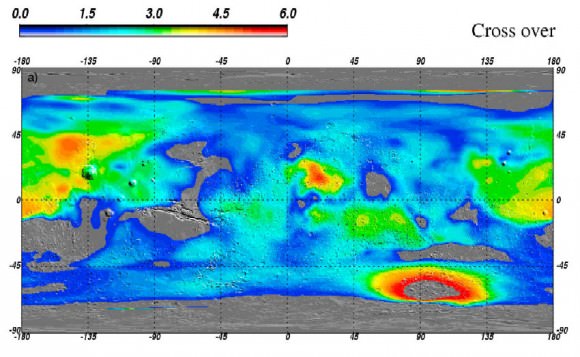
Preliminary experiments have shown that Mars soil could be baked into bricks to create protective structures, which would reduce the amount of material that needs to be shipped to the surface. Earth plants could eventually be grown in Martian soil too, assuming they get enough sunlight and carbon dioxide. Over time, planting on the native soil could also help to create a breathable atmosphere.
Challenges:
Despite the aforementioned benefits, there are also some rather monumental challenges to colonizing the Red Planet. For starters, there is the matter of the average surface temperature, which is anything but hospitable. While temperatures around the equator at midday can reach a balmy 20 °C, at the Curiosity site – the Gale Crater, which is close to the equator – typical nighttime temperatures are as low as -70 °C.
The gravity on Mars is also only about 40% of what we experience on Earth’s, which would make adjusting to it quite difficult. According to a NASA report, the effects of zero-gravity on the human body are quite profound, with a loss of up to 5% muscle mass a week and 1% of bone density a month.
Naturally, these losses would be lower on the surface of Mars, where there is at least some gravity. But permanent settlers would still have to contend with the problems of muscle degeneration and osteoporosis in the long run.
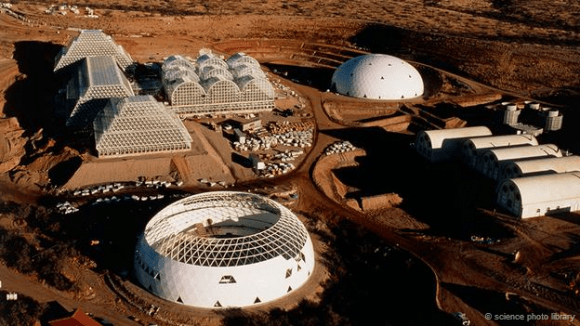
And then there’s the atmosphere, which is unbreathable. About 95% of the planet’s atmosphere is carbon dioxide, which means that in addition to producing breathable air for their habitats, settlers would also not be able to go outside without a pressure suit and bottled oxygen.
Mars also has no global magnetic field comparable to Earth’s geomagnetic field. Combined with a thin atmosphere, this means that a significant amount of ionizing radiation is able to reach the Martian surface.
Thanks to measurements taken by the Mars Odyssey spacecraft’s Mars Radiation Environment Experiment (MARIE), scientists learned that radiation levels in orbit above Mars are 2.5 times higher than at the International Space Station. Levels on the surface would be lower, but would still be higher than human beings are accustomed to.
In fact, a recent paper submitted by a group of MIT researchers – which analyzed the Mars One plan to colonize the planet beginning in 2020 – concluded that the first astronaut would suffocate after 68 days, while the others would die from a combination of starvation, dehydration, or incineration in an oxygen-rich atmosphere.
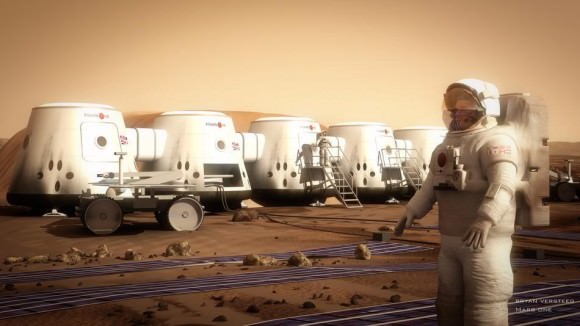
In short, the challenges to creating a permanent settlement on Mars are numerous, but not necessarily insurmountable. And if we do decide, as individuals and as a species, that Mars is to become a second home for humanity, we will no doubt find creative ways to address them all.
Who knows? Someday, perhaps even within our own lifetimes, there could be real Martians. And they would be us!
Universe Today has many interesting articles about the possibility of humans living on Mars. Here’s a great article by Nancy Atkinson about the possibility of a one-way, one-person trip to Mars
What about using microbes to help colonize mars? And if you want to know the distances between Earth and Mars, check it out here.
For more information, check out Mars colonies coming soon, Hubblesite’s News Releases about Mars, and NASA’s Quick Facts
The Mars Society is working to try and colonize Mars. And Red Colony is a great resource of articles about colonizing Mars.
Finally, if you’d like to learn more about Mars in general, we have done several podcast episodes about the Red Planet at Astronomy Cast. Episode 52: Mars, Episode 91: The Search for Water on Mars, and Episode 94: Humans to Mars – Part 1, Scientists.

